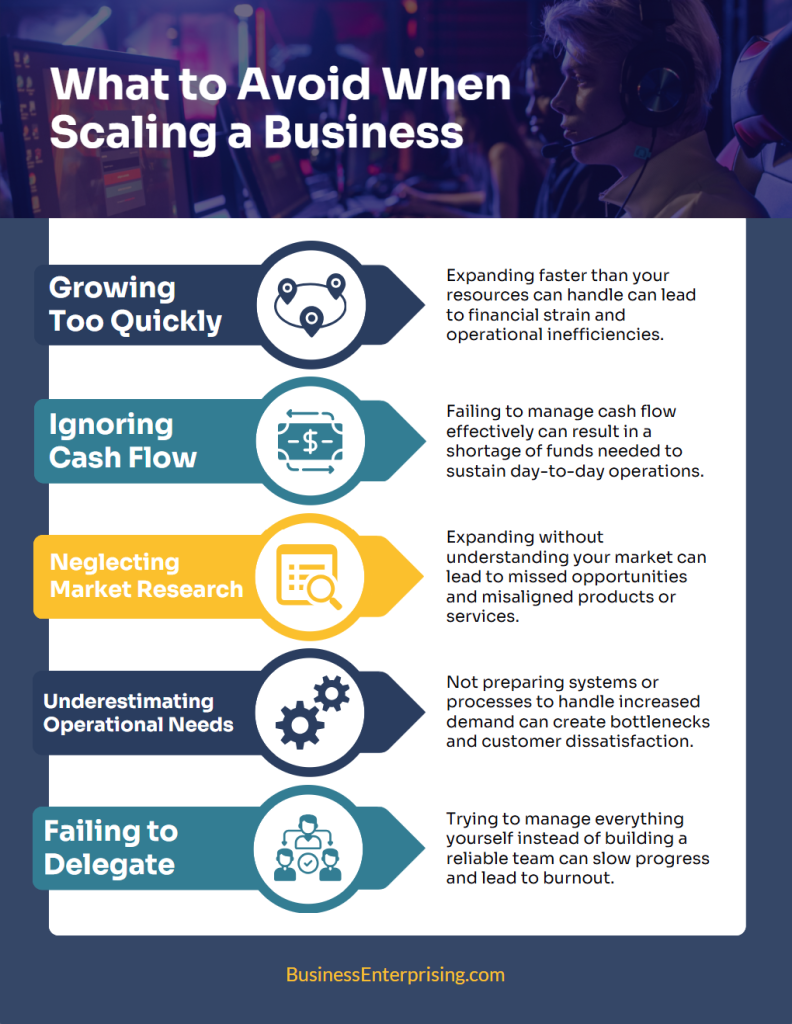
Whether it’s improving operations, expanding your team, or leveraging technology, every decision matters. Additionally, adapting to market demands and customer needs helps you stay competitive as you grow. A well-structured approach reduces risks and maximizes opportunities for success.
Growth doesn’t happen overnight, and each step builds on the last. Therefore, staying focused on long-term objectives keeps your efforts aligned with your vision. By approaching scaling as a series of intentional actions, you can manage the challenges and achieve sustainable progress. Success comes from combining preparation, adaptability, and strategic thinking throughout the process.
1. Assessing Your Business Readiness for Scaling
Assessing your business readiness for scaling is one of the most important of the 10 steps for scaling a business successfully. Before you begin, it’s essential to evaluate whether your current operations can handle the demands of growth. For example, review your workflows to identify inefficiencies that could slow you down. By addressing bottlenecks early, you can build a foundation that supports expansion.
Additionally, take a close look at your resources. Do you have the necessary team, tools, and capital to manage increased demand? If not, it may be time to hire key personnel or invest in technology. However, scaling without these resources in place can strain your business and lead to missed opportunities. Preparing your resources in advance helps you scale efficiently and avoid unnecessary setbacks.
Finally, consider your scalability potential by analyzing customer demand and market trends. Are your products or services positioned to meet growing needs? If not, adjustments may be required to align with market opportunities. Additionally, reviewing data from your current performance can help you predict how scaling might impact profitability. By taking these steps, you can confidently move forward with your scaling strategy and create a sustainable growth plan.
2. Defining Clear and Measurable Goals
Defining clear and measurable goals is essential when creating a growth strategy. Without specific objectives, it becomes difficult to track progress. Additionally, vague or unrealistic goals can lead to wasted time and effort. By setting clear targets, you create a roadmap that helps you focus on what matters most.
However, your goals must also be measurable to evaluate success effectively. For example, instead of aiming to “increase revenue,” set a specific percentage or dollar amount to achieve. This approach allows you to monitor your progress and adjust strategies as needed. Additionally, measurable goals give your team a clear direction and keep everyone aligned during growth.
Clear goals also help prioritize the steps for scaling a business. By identifying what success looks like, you can allocate resources more effectively. For instance, if your objective is to expand into new markets, you can focus on marketing efforts or partnerships. Therefore, taking the time to define measurable goals ensures that your growth strategy is both actionable and achievable.
3. Streamlining Operations and Processes
Streamlining operations and processes is a key step in preparing for growth. Identifying inefficiencies allows you to eliminate unnecessary delays and redundancies. For example, outdated workflows or manual tasks may be slowing your productivity. By addressing these issues, you create a more efficient system that supports scaling.
However, improving efficiency often requires the implementation of new tools or systems. Automating repetitive tasks can save both time and resources, allowing your team to focus on higher-value activities. Additionally, integrating software that centralizes operations can improve communication and collaboration. These changes help ensure your business is better equipped to handle the demands of growth.
Streamlining is one of the most important of the 10 steps for scaling a business successfully. Therefore, you should regularly evaluate your processes to identify areas for improvement. For example, track key performance metrics to spot bottlenecks or slowdowns. By taking proactive steps to improve efficiency, you can position your business for smoother operations and sustainable growth.
4. Building a Scalable Infrastructure
Building a scalable infrastructure is an essential part of preparing for business growth. Technology plays a significant role in this process. For example, cloud-based systems allow you to expand operations without significant upfront costs. By adopting flexible technology, you can handle increased demand more efficiently.
Automation is another key factor in scaling. Automating repetitive tasks, such as inventory management or customer communication, saves time and reduces human error. Additionally, automation frees up your team to focus on more strategic responsibilities. These tools not only improve efficiency but also support smoother operations as your business grows.
Investing in the right tools is one of the most important steps for scaling a business. Tools that integrate data and processes across departments can simplify workflows and improve collaboration. However, it’s important to regularly evaluate your technology stack to ensure it aligns with your scaling needs. By building an infrastructure that grows with you, you set your business up for long-term success.
5. Expanding Your Team Strategically
Expanding your team strategically is an important part of preparing for growth. Hiring key personnel at the right time is critical. However, adding too many employees too early can strain your resources. Additionally, waiting too long to hire may leave your team overwhelmed and limit your ability to scale effectively.
Start by identifying specific gaps in your current team. Determine which roles are essential for supporting your growth plans. For example, if customer demand is increasing, you may need to hire more support staff. Additionally, consider hiring specialists with skills that align with your long-term goals. Bringing in the right expertise can help drive your expansion forward.
Hiring is one of the most important steps for scaling a business. Therefore, you should focus on candidates who fit your company’s culture and values. Building a cohesive team improves collaboration and productivity. Regularly reassess your hiring needs as your business grows. By expanding your team thoughtfully, you create a solid foundation for sustainable growth.
6. Understanding Your Market and Audience
Understanding your market and audience is key to staying competitive as your business grows. Customer needs and market demands can change quickly. Therefore, regularly analyzing your audience helps you adapt and remain relevant. Ignoring these changes may lead to missed opportunities or declining sales.
Adapting your offerings involves listening to your customers and studying market trends. For example, feedback from customers can highlight new features or services they value. Additionally, analyzing competitors may reveal gaps you can fill to differentiate your business. By staying informed, you can adjust your strategies to meet evolving demands.
Listening to your audience is one of the most effective steps for scaling a business. This process helps you identify opportunities for growth while building stronger customer relationships. However, adapting doesn’t mean changing your business completely. Instead, it involves refining what you already do well to align with market needs. By focusing on your audience, you create a solid foundation for sustained success.
7. Creating a Strong Financial Plan
Creating a strong financial plan is essential for managing growth successfully. Cash flow management plays a significant role in this process. Without proper oversight, you risk running into cash shortages that can disrupt operations. Therefore, monitoring your income and expenses regularly allows you to avoid unnecessary surprises and plan for the future.
Funding growth requires a clear understanding of your financial needs. For example, you may need additional resources to expand operations or invest in new technology. Additionally, securing funding through loans, investors, or other sources can help bridge financial gaps. However, it’s important to evaluate these options carefully to avoid overextending your business.
Maintaining profitability is one of the most important of the 10 steps for scaling a business. While growth often comes with added costs, managing those expenses is key to staying sustainable. Regularly reviewing your financial plan ensures that you remain aligned with your goals. By focusing on cash flow, funding, and profitability, you create a financial foundation that supports long-term success.
8. Leveraging Marketing and Sales Strategies
Leveraging marketing and sales strategies is an important step in growing your business. To amplify your brand’s reach, you must connect with the right audience. However, this requires a deep understanding of who your customers are and where they spend their time. Adopting a multi-channel approach, such as combining social media and email marketing, helps you engage with your audience effectively.
Sales strategies also play a significant role in increasing revenue streams. For example, creating targeted offers or promotions can encourage existing customers to purchase more. Additionally, upselling and cross-selling related products can boost your sales without requiring a significant increase in resources. By tailoring your sales tactics to meet customer needs, you create opportunities to drive revenue growth.
Effective marketing and sales strategies are important steps for scaling a business. Therefore, you should continuously evaluate and refine your efforts. Use data and customer feedback to identify what works and where improvements are needed. Additionally, staying consistent with your branding and messaging strengthens your relationship with your audience. With thoughtful strategies in place, you can grow your reach and revenue while maintaining a solid connection with your customers.
9. Building Partnerships and Networks
Building partnerships and networks is a powerful way to accelerate growth. Collaborating with other businesses helps you access new markets and resources. For example, a strategic partnership can allow you to share expertise, reduce costs, or expand your customer base. Additionally, partnerships often create opportunities for joint marketing efforts, amplifying your brand’s visibility.
Networking also plays a key role in scaling your business. By connecting with industry professionals, you gain valuable insights and potential referrals. However, building meaningful relationships takes time and effort. Attend industry events, engage with local business communities, and focus on creating mutual value. Strong networks often open doors to new collaborations and growth opportunities.
Forming partnerships and expanding networks are essential steps for scaling a business. Therefore, it’s important to carefully select partners who align with your values and goals. A poorly matched partnership can lead to inefficiencies or conflicts. By investing in the right relationships, you can create a support system that fosters sustainable growth and innovation.
10. Measuring Progress and Adapting as You Scale
Measuring progress and adapting are key steps in scaling your business effectively. Growth can introduce new challenges that require careful adjustments. However, relying on data-driven insights allows you to track performance and identify areas for improvement. Regularly reviewing metrics ensures that your strategies remain aligned with your goals.
Adapting as you scale involves refining your approach based on measurable results. For example, if a specific marketing strategy underperforms, you can shift resources to more effective channels. Additionally, tracking operational data can highlight inefficiencies that may need attention. By making these adjustments, you can stay agile and respond to changing demands.
Using measurable goals and data-driven decisions is one of the most effective of the 10 steps for scaling a business. Therefore, it’s important to set clear benchmarks and monitor progress consistently. Long-term growth requires staying focused on your objectives while remaining flexible. With the right tools and insights, you can continuously improve and sustain your business’s success over time.
Conclusion
Scaling a business is an exciting yet challenging process. Taking deliberate and thoughtful steps ensures your growth is sustainable and effective. However, scaling requires more than just ambition; it demands strategic planning and adaptability. Each action you take should align with your long-term goals while addressing immediate needs.
These 10 steps for scaling a business involve balancing growth with efficiency. From refining your operations to leveraging partnerships, each decision impacts your ability to grow successfully. Additionally, tracking progress and remaining flexible allows you to adapt to changing demands. By staying focused and using data-driven insights, you can refine your strategies as your business evolves.
As you scale, remember that growth is a journey, not a single destination. Challenges are inevitable, but with careful planning, they become opportunities to learn and improve. By following structured steps and adapting as needed, you can create a foundation for long-term success. Your business can thrive and expand when each decision supports both current and future goals.



